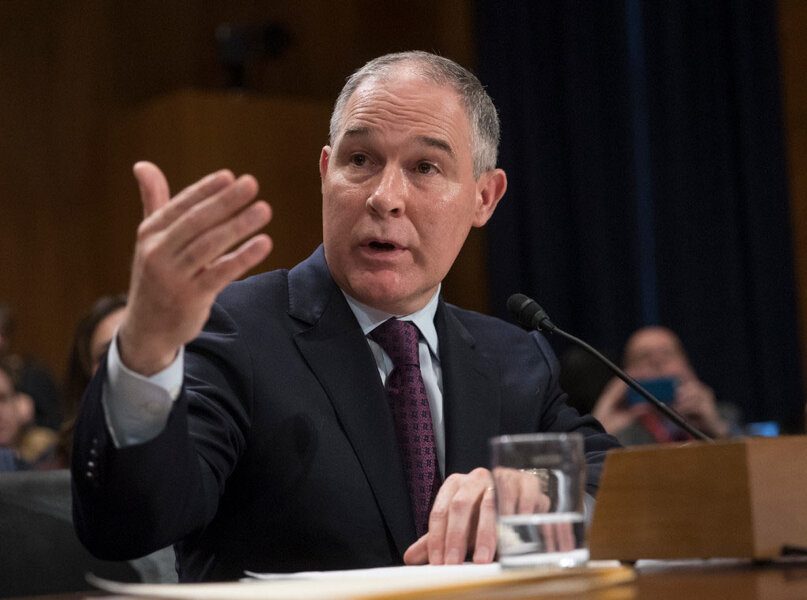EPA scientists held back from conference: Cost-cutting or something more?
Loading...
At this week’s Alaska Forum on the Environment, 17 EPA employees were no-shows – and not by choice.
The agency had planned to send 34 staff members to the week-long conference, which hosted discussions on a wide range of environmental issues facing Alaska. But after the White House transition team demanded cutbacks, the Environmental Protection Agency only allowed half to attend.
EPA spokesman Doug Ericksen cast this decision as a cost-saving measure, calling it "one small example of how EPA will be working cooperatively with our staff and our outside partners to be better stewards of the American people's money."
But, as Bloomberg’s Christopher Flavelle and Jennifer Dlouhy noted, the EPA’s announcement comes after months of criticism by President Trump and his advisors, and a paring-down of climate science on government websites.
Regardless of the motives behind this particular action, it continues a years-long trend of cuts to government agencies’ travel funds. Scientific research, which involves a regular exchange of ideas and findings, has been hit especially hard.
The high costs of scientific conferences are a frequent issue for Keith Seitter, the executive director of the American Meteorological Society, who spoke with The Christian Science Monitor in a phone interview.
“I think there's a real sense within the [scientific] community that those costs are small compared to the benefits," he says. "That cost-benefit ratio sometimes gets lost in the discussion.”
At conferences, he continues, it's often casual interactions – “the discussions that happen in the hallways” – that spark productive research collaborations.
But funding cuts have kept many government scientists from attending these events in recent years.
The federal government faced major pressure to curb travel spending in 2012, when an Inspector General’s report revealed that the General Services Administration had spent more than $820,000 on a lavish conference in Las Vegas. The Office of Management and Budget promptly issued a memo directing each federal agency to spend 30 percent less on travel than it had in 2010.
“It had a big impact on us,” Dr. Seitter remembers. “We saw fewer attendees coming from government labs.”
A Government Accountability Office report cited by Congress found that conference attendance from the Army Research Laboratory and Sandia National Laboratory fell by about 1,200 employees each between 2011 and 2013.
Scientific societies such as the American Institute of Physics and the Institute of Electrical and Electronics Engineers have argued that having fewer government scientists at conferences reduced their productivity.
“We heard a lot of feedback from folks who work in the government that it was impeding their ability to do research as effectively as they had in the past,” Seitter recalls.
He says he understands concerns about high costs to taxpayers. The EPA's Doug Ericksen told NPR that the agency spent an eyebrow-raising $44 million on travel in 2016.
But Seitter insists that, when it comes to conferences, that's money well spent. "The benefit of scientists being able to get together with other scientists to work through the issues that they're dealing with just has an enormous payback, and I think sometimes the value of those meetings gets a little lost by people who are looking just at the cost of travel."
This week’s Alaska Forum on the Environment wasn’t exclusively for scientists. In addition to federal agencies like the Centers for Disease Control and Prevention (CDC) and the National Oceanic and Atmospheric Administration (NOAA), it featured military personnel and representatives from Alaska’s state, local, and tribal governments.
Its panels addressed topics such as climate change, oil spills, and hazardous waste, which have both science and public policy aspects.
“When you're able to bring together people who are coming from these different perspectives on an issue,” Seitter argues, “it's almost impossible for that not to generate the kind of discussions that can lead to better solutions.”
The EPA’s under-representation may have limited those discussions, however. At a panel “slated to include six EPA staff members discussing Alaska EPA grants, only two EPA officials were at the front of the room taking questions,” according to Bloomberg. Many of those questions focused not on grants, but on “how the agency might be changing.”
Mr. Trump made no secret of his disdain for the EPA during the campaign, and has nominated Scott Pruitt, who has voiced skepticism on the causes of climate change, to head the agency. This decision, along with others like a request for the names of Energy Department employees who had worked on climate change, has climate scientists and environmental groups wondering about Trump's plans.
But Seitter hopes that robust conference participation, at least, can continue.
"It's critically important for all of the scientists to be able to get together," he says.






